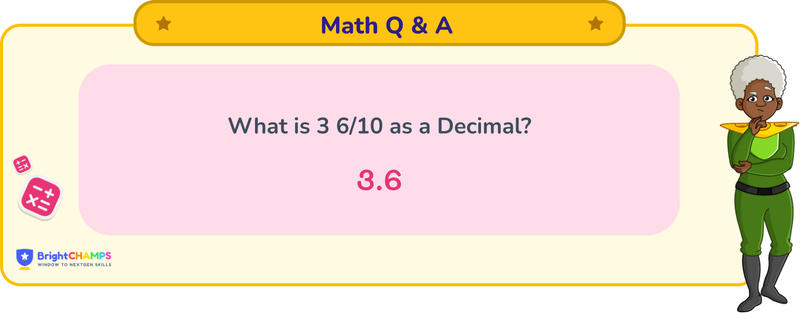
 239 Learners
239 LearnersLast updated on 5 August 2025

3 6/10 as a Decimal

It is a simple question on decimal conversion. Firstly, we need to understand fractions and decimals. A fraction represents a part of the whole. It has two parts: the numerator (number on top), here 36, which represents how many parts out of the whole, and the denominator (number below), here it is 10, showing how many parts make the whole. A decimal is a way to represent a number that is not whole, using a decimal point (.) to separate the whole part from the fractional part. The numbers to the left of the decimal point represent the whole number, and those to the right represent the fractional part.
What is 3 6/10 as a decimal?

Answer
3 6/10 in decimal form can be written as 3.6. It is a terminating decimal, meaning it does not repeat infinitely.
Explanation
To convert 3 6/10 to a decimal, we will focus on the fraction 6/10. We will use division to convert it. Here, 6 is smaller than 10, so we can directly divide. Let's break down the process step by step:
Step 1: Identify the fraction part, where 6 is the numerator (dividend) and 10 is the denominator (divisor).
Step 2: Divide the numerator by the denominator: 6 ÷ 10 = 0.6.
Step 3: Combine the whole number with the decimal obtained from the fraction. Here, the whole number is 3, so we add 0.6 to 3, resulting in 3.6.
The answer for 3 6/10 as a decimal is 3.6.
Important Glossaries for 3 6/10 as a decimal
- Fraction: A numerical quantity that is not a whole number, representing a part of a whole.
- Decimal: A number that uses the base ten and includes a decimal point to separate the whole part from the fractional part.
- Numerator: The top part of a fraction, indicating how many parts of the whole are being considered.
- Denominator: The bottom part of a fraction, showing how many parts make up a whole.
- Terminating Decimal: A decimal that ends and does not repeat infinitely.




